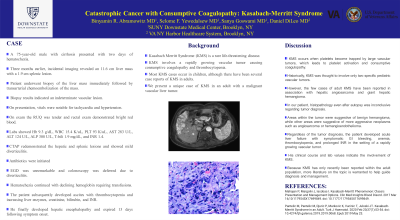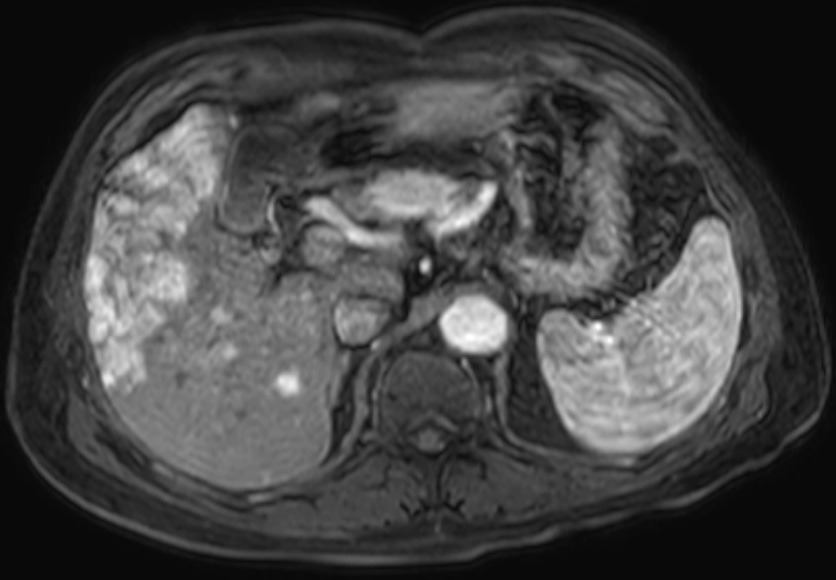Sunday Poster Session
Category: Liver
P1110 - Catastrophic Cancer With Consumptive Coagulopathy: Kasabach-Merritt Syndrome
Sunday, October 22, 2023
3:30 PM - 7:00 PM PT
Location: Exhibit Hall

Has Audio
- BA
Binyamin R. Abramowitz, MD
SUNY Downstate Health Sciences University
Brooklyn, New York
Presenting Author(s)
Binyamin R. Abramowitz, MD1, Selome F. Yewedalsew, MD1, Sanya Goswami, MD1, Daniel Dileo, MD2
1SUNY Downstate Health Sciences University, Brooklyn, NY; 2Brooklyn VA Medical Center, Brooklyn, NY
Introduction: Kasabach Merritt Syndrome (KMS) is a rare life-threatening disease in which a rapidly growing vascular tumor causes consumptive coagulopathy and thrombocytopenia. Although most cases occur in children, there are a few case reports of KMS in adults. We present a unique case of KMS in an adult with a malignant vascular liver tumor.
Case Description/Methods: A 75-year-old male with cirrhosis presented with two days of hematochezia. Three months earlier, incidental imaging revealed an 11.6 cm liver mass with a 1.9 cm splenic lesion. He underwent biopsy of the liver mass immediately followed by transarterial chemoembolization of the mass. Biopsy results indicated an indeterminate vascular lesion. On presentation, vitals were notable for tachycardia and hypertension. On exam the RUQ was tender and rectal exam demonstrated bright red blood. Labs showed Hb 9.3 g/dL, WBC 15.4 K/uL, PLT 93 K/uL, AST 283 U/L, ALT 124 U/L, ALP 308 U/L, T-bili 1.9 mg/dL, and INR 1.4. Computer tomography of the abdomen and pelvis redemonstrated the hepatic and splenic lesions and showed mild diverticulitis. Antibiotics were started. Esophagogastroduodenoscopy was unremarkable and colonoscopy was deferred due to diverticulitis. Hematochezia continued with declining hemoglobin requiring transfusions. The patient subsequently developed ascites with thrombocytopenia and increasing liver enzymes, creatinine, bilirubin, and INR. He finally developed hepatic encephalopathy and expired 13 days following symptom onset.
Discussion: KMS occurs when platelets become trapped by large vascular tumors, which leads to platelet activation and consumptive coagulopathy. Historically, KMS was thought to involve only two specific pediatric vascular tumors. However, the few cases of adult KMS have been reported in association with hepatic angiosarcoma and giant hepatic hemangioma. In our patient, histopathology even after autopsy was inconclusive regarding tumor diagnosis. Areas within the tumor were suggestive of benign hemangioma, while other areas were suggestive of more aggressive neoplasms such as angiosarcoma or hemangioendothelioma. Regardless of the tumor diagnosis, the patient developed acute liver failure with symptomatic GI bleeding, anemia, thrombocytopenia, and prolonged INR in the setting of a rapidly growing vascular tumor, indicating the involvement of KMS. Because KMS has only recently been reported within the adult population, more literature on the topic is warranted to help guide diagnosis and management.

Disclosures:
Binyamin R. Abramowitz, MD1, Selome F. Yewedalsew, MD1, Sanya Goswami, MD1, Daniel Dileo, MD2. P1110 - Catastrophic Cancer With Consumptive Coagulopathy: Kasabach-Merritt Syndrome, ACG 2023 Annual Scientific Meeting Abstracts. Vancouver, BC, Canada: American College of Gastroenterology.
1SUNY Downstate Health Sciences University, Brooklyn, NY; 2Brooklyn VA Medical Center, Brooklyn, NY
Introduction: Kasabach Merritt Syndrome (KMS) is a rare life-threatening disease in which a rapidly growing vascular tumor causes consumptive coagulopathy and thrombocytopenia. Although most cases occur in children, there are a few case reports of KMS in adults. We present a unique case of KMS in an adult with a malignant vascular liver tumor.
Case Description/Methods: A 75-year-old male with cirrhosis presented with two days of hematochezia. Three months earlier, incidental imaging revealed an 11.6 cm liver mass with a 1.9 cm splenic lesion. He underwent biopsy of the liver mass immediately followed by transarterial chemoembolization of the mass. Biopsy results indicated an indeterminate vascular lesion. On presentation, vitals were notable for tachycardia and hypertension. On exam the RUQ was tender and rectal exam demonstrated bright red blood. Labs showed Hb 9.3 g/dL, WBC 15.4 K/uL, PLT 93 K/uL, AST 283 U/L, ALT 124 U/L, ALP 308 U/L, T-bili 1.9 mg/dL, and INR 1.4. Computer tomography of the abdomen and pelvis redemonstrated the hepatic and splenic lesions and showed mild diverticulitis. Antibiotics were started. Esophagogastroduodenoscopy was unremarkable and colonoscopy was deferred due to diverticulitis. Hematochezia continued with declining hemoglobin requiring transfusions. The patient subsequently developed ascites with thrombocytopenia and increasing liver enzymes, creatinine, bilirubin, and INR. He finally developed hepatic encephalopathy and expired 13 days following symptom onset.
Discussion: KMS occurs when platelets become trapped by large vascular tumors, which leads to platelet activation and consumptive coagulopathy. Historically, KMS was thought to involve only two specific pediatric vascular tumors. However, the few cases of adult KMS have been reported in association with hepatic angiosarcoma and giant hepatic hemangioma. In our patient, histopathology even after autopsy was inconclusive regarding tumor diagnosis. Areas within the tumor were suggestive of benign hemangioma, while other areas were suggestive of more aggressive neoplasms such as angiosarcoma or hemangioendothelioma. Regardless of the tumor diagnosis, the patient developed acute liver failure with symptomatic GI bleeding, anemia, thrombocytopenia, and prolonged INR in the setting of a rapidly growing vascular tumor, indicating the involvement of KMS. Because KMS has only recently been reported within the adult population, more literature on the topic is warranted to help guide diagnosis and management.

Figure: MRI Abdomen shows an 11 cm confluent nodular liver mass along with several other hepatic lesions
Disclosures:
Binyamin Abramowitz indicated no relevant financial relationships.
Selome Yewedalsew indicated no relevant financial relationships.
Sanya Goswami indicated no relevant financial relationships.
Daniel Dileo indicated no relevant financial relationships.
Binyamin R. Abramowitz, MD1, Selome F. Yewedalsew, MD1, Sanya Goswami, MD1, Daniel Dileo, MD2. P1110 - Catastrophic Cancer With Consumptive Coagulopathy: Kasabach-Merritt Syndrome, ACG 2023 Annual Scientific Meeting Abstracts. Vancouver, BC, Canada: American College of Gastroenterology.
